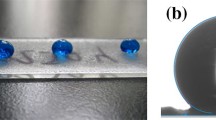Abstract
A superhydrophobic nanocomposite coating was fabricated using a simple procedure. The nanocomposite is composed of an acrylic copolymer and modified silica nanoparticles. The acrylic copolymer was prepared by free radical copolymerization of methyl methacrylate and dodeycl methacrylate monomers. Silica nanoparticles were synthesized and modified with an alkyl silane reagent, hexadecyltrimethoxysilane. A mixture of acrylic copolymer and modified silica nanoparticles, dispersed in dichloromethane, was then sprayed on glass and filter paper surface. Chemical composition and structure of the coatings were investigated by FTIR, FESEM, AFM, 1H-NMR and GPC. The wettability of the prepared coating was examined by water contact angle measurement. The results showed that superhydrophobic surfaces with contact angle above 150° and rough structures were obtained. The prepared coatings also exhibited superoleophilic and self-cleaning properties.












Similar content being viewed by others
References
Ganesh VA, Raut HK, Nair AS et al (2011) A review on self-cleaning coatings. J Mater Chem 21(41):16304–16322
Guo Z, Liu W, Su BL (2011) Superhydrophobic surfaces: from natural to biomimetic to functional. J Colloid Interface Sci 353(2):335–355
Ruan M, Li W, Wang B et al (2013) Preparation and anti-icing behavior of superhydrophobic surfaces on aluminum alloy substrates. Langmuir 29(27):8482–8491
Xue CH, Guo XJ, Ma JZ et al (2015) Fabrication of robust and antifouling superhydrophobic surfaces via surface-initiated atom transfer radical polymerization. ACS Appl Mater Interfaces 7(15):8251–8259
Wang H, Liu Z, Zhu Y et al (2016) Facile preparation of superhydrophobic and high oleophobic polymer composite coatings with self-cleaning, heat-resistance and wear-resistance. J Polym Res 23(7):1–9
Cao M, Guo D, Yu C et al (2015) Water-repellent properties of superhydrophobic and lubricant-infused “slippery” surfaces: a brief study on the functions and applications. ACS Appl Mater Interfaces 8(6):3615–3623
Yan YY, Gao N, Barthlott W (2011) Mimicking natural superhydrophobic surfaces and grasping the wetting process: a review on recent progress in preparing superhydrophobic surfaces. Adv Colloid Interface Sci 169(2):80–105
Oktay B, Toker RD, Kayaman-Apohan N (2015) Superhydrophobic behavior of polyimide–siloxane mats produced by electrospinning. Polym Bull 72(11):2831–2842
Liao R, Zuo Z, Guo C et al (2014) Fabrication of superhydrophobic surface on aluminum by continuous chemical etching and its anti-icing property. Appl Surf Sci 317:701–709
Xie L, Tang Z, Jiang L et al (2015) Creation of superhydrophobic wood surfaces by plasma etching and thin-film deposition. Surf Coat Technol 281:125–132
Peng P, Ke Q, Zhou G et al (2013) Fabrication of microcavity-array superhydrophobic surfaces using an improved template method. J Colloid Interface Sci 395:326–328
Zhang C, Zhang S, Gao P et al (2014) Superhydrophobic hybrid films prepared from silica nanoparticles and ionic liquids via layer-by-layer self-assembly. Thin Solid Films 570:27–32
Sung YH, Kim YD, Choi HJ et al (2015) Fabrication of superhydrophobic surfaces with nano-in-micro structures using UV-nanoimprint lithography and thermal shrinkage films. Appl Surf Sci 349:169–173
Mahadik SA, Vhatkara RS, Mahadik DB et al (2013) Superhydrophobic silica coating by dip coating method. Appl Surf Sci 277:67–72
Ogihara H, Xie J, Okagaki J et al (2012) Simple method for preparing superhydrophobic paper: spray-deposited hydrophobic silica nanoparticle coatings exhibit high water-repellency and transparency. Langmuir 28(10):4605–4608
Mahadik SA, Fernando PD, Hegade ND et al (2013) Durability and restoring of superhydrophobic properties in silica-based coatings. J Colloid Interface Sci 405:262–268
Wang Y, Li B, Liu T et al (2014) Controllable fabrication of superhydrophobic TiO2 coating with improved transparency and thermostability. Colloids Surf A 441:298–305
Liu Z, Wang H, Wang E et al (2016) Superhydrophobic poly (vinylidene fluoride) membranes with controllable structure and tunable wettability prepared by one-step electrospinning. Polymer 82:105–113
Ye Z, Chen Y, Yang X et al (2017) Development of perfluoropolyether modified raspberry particles with fine hierarchical structure and their application in superhydrophobic surface. Colloids Surf 514:251–259
Yang H, Pi P, Yang ZR et al (2016) Design of a superhydrophobic and superoleophilic film using cured fluoropolymer@silica hybrid. Appl Surf Sci 388:268–273
Chu Z, Seeger S (2015) Robust superhydrophobic wood obtained by spraying silicone nanoparticles. RSC Adv 5(28):21999–22004
Yuan R, Wu S, Wang H et al (2017) Facile fabrication approach for a novel multifunctional superamphiphobic coating based on chemically grafted montmorillonite/Al2O3-polydimethylsiloxane binary nanocomposite. J Polym Res 24(4):59
Neto AI, Meredith HJ, Jenkins CL et al (2013) Combining biomimetic principles from the lotus leaf and mussel adhesive: polystyrene films with superhydrophobic and adhesive layers. RSC Adv 3(24):9352–9356
Ma Y, Cao X, Feng X et al (2007) Fabrication of super-hydrophobic film from PMMA with intrinsic water contact angle below 90. Polymer 48(26):7455–7460
Guo YG, Jiang D, Zhang Zhang X et al (2010) Room temperature synthesis of water-repellent polystyrene nanocomposite coating. Appl Surf Sci 256(23):7088–7090
Porter CE, Blum FD (2000) Thermal characterization of PMMA thin films using modulated differential scanning calorimetry. Macromolecules 33(19):7016–7020
Gurav AB, Xu Q, Latthe SS et al (2015) Superhydrophobic coatings prepared from methyl-modified silica particles using simple dip-coating method. Ceram Int 41(2):3017–3023
Young T (1805) An essay on the cohesion of fluids. Philos Trans R Soc Lond B Biol Sci 95:65–87
Wenzel RN (1936) Resistance of solid surfaces to wetting by water. Ind Eng Chem 28(8):988–994
Cassie A, Baxter S (1944) Wettability of porous surfaces. Trans Faraday Soc 40:546–551
Zhu Q, Chu Y, Wang Z et al (2013) Robust superhydrophobic polyurethane sponge as a highly reusable oil-absorption material. J Mater Chem A 1(17):5386–5393
Ge B, Zhang Z, Zhu X et al (2014) A superhydrophobic/superoleophilic sponge for the selective absorption oil pollutants from water. Colloids Surf A 457:397–401
Peng L, Lei W, Yu P et al (2016) Polyvinylidene fluoride (PVDF)/hydrophobic nano-silica (H–SiO2) coated superhydrophobic porous materials for water/oil separation. RSC Adv 6(13):10365–10371
Author information
Authors and Affiliations
Corresponding author
Rights and permissions
About this article
Cite this article
Pourjavadi, A., Esmaili, H. & Nazari, M. Facile fabrication of superhydrophobic nanocomposite coating using modified silica nanoparticles and non-fluorinated acrylic copolymer. Polym. Bull. 75, 4641–4655 (2018). https://doi.org/10.1007/s00289-018-2284-3
Received:
Revised:
Accepted:
Published:
Issue Date:
DOI: https://doi.org/10.1007/s00289-018-2284-3




